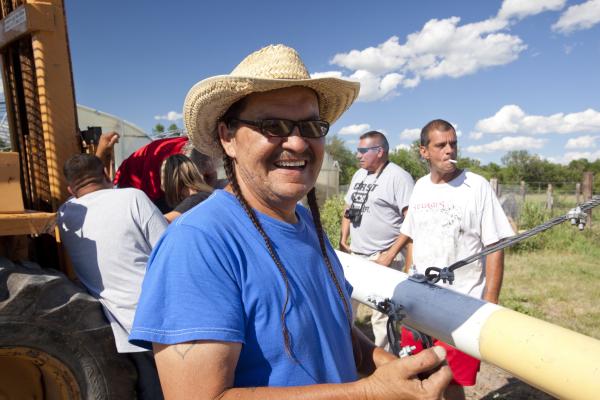http://www.commondreams.org/view/2014/04/22-0
Published on Tuesday, April 22, 2014
by Winona LaDuke

Henry Red Cloud. (Photo: treeswaterpeople.wordpress.com)There are two very different ways of recognizing Earth Day In the Northern Plains and Washington, perhaps illustrating, what Native people call the choice between two paths, one well scorched and worn, the other green.
This past week, Henry Red Cloud, a descendent of Chief Red Cloud and President of Lakota Solar Enterprises, was recognized as a Champion of Change by President Obama for his leadership in renewable energy. Red Cloud’s work has included installation of over 1000 solar thermal heating units on houses in tribal communities across the Northern Plains. Those units can reduce heating bills by almost one quarter, and cost, less than $2000 to install. The solar thermal panels harken a future with less reliance on propane and fossil fuels, something which proved deadly this winter, as the price skyrocketed, and many homes spent at least that amount to heat.
Henry Red Cloud is one of many Lakota people who has been in DC this past month, and a large number of other Oglala tribal members will descend on Washington for the Cowboys Indians Alliance encampment against the Keystone XL pipeline. Henry Red Cloud sees solar energy as a way to “honor the old ways in the new times,” and address some of the fuel poverty which is rampant in northern plains and north woods first nations, in an era of petroleum, replacing natural fuels. Annually tribes are forced to pay hundreds of millions of dollars of propane bills, to keep houses warm, and fuel poverty is when tribal members have to choose between heating or eating. “Last year, more than five million was spent on propane and electricity to keep our members warm,” Red Cloud explained. “We can take that money and turn it around, start some businesses.”
Solar thermal heat, not only keeps people warm, reducing the hemorrhage of fuel bills but it circulates money into a local economy. The solar panels are made on the reservation, and the Red Cloud Renewable Energy center near Oglala, on the reservation employs nine full time workers and several part time workers in the busy season. That is money helping a community and rebuilding infrastructure in that community.
According to Henry Red Cloud and many others is what we need to do. After all, about 14% of reservation households are without electricity, 10 times the national rate. Energy distribution systems on rural reservations are extremely vulnerable to extended power outages during winter storms, threatening the lives of reservation residents. Reservation communities are at a statistically greater risk from extreme weather related mortality nationwide, especially from cold, heat and drought associated with a rapidly changing climate. Reservations need more than 200,000 new houses, and there is no money for them, and Pine Ridge, Henry’s home may be one of the most impacted areas. This is also the home of strong opposition to the Keystone XL pipeline, also known as the “fat takers pipeline,” by the Lakota people. Brian Brewer, president of the Oglala Sioux Tribe, told press, “No Keystone XL Black Snake Pipeline will cross Lakota Lands. We will protect our lands and waters and we have our horses ready…”
The proposed Keystone XL pipeline, will put in infrastructure as well. As Henry and others point out, that infrastructure will not change the conditions for most people in the northern plains, whom the pipeline will pass. Employment will not be local, or of long term. The man camps of a thousand men will move in, buy some things, stay at hotels, and then move on. And the infrastructure will not improve for the people.
The $7 billion price tag of the Keystone XL was studied in a recent report by Economics for Equity and the Environment. The study found that spending money on unmet water and gas infrastructure needs in the five relevant states along the KXL pipeline route will create more than 300,000 total jobs across all sectors, or five times more jobs than the KXL, with ninety five times more long term jobs. Spending money on the infrastructure in this country, which has received a D + rating from the national engineers, would provide more jobs, and more benefits to American people over the long term, like infrastructure which does not leak or blow up.
In his State of the Union address, President Obama noted that last year the amount of solar power installed in the U.S. has increased around eleven fold—from 1.2 gigawatts in 2008 to an estimated 13 gigawatts in 2014. Solar thermal is even less expensive and applicable to many south facing walls. Last June, President Obama announced a comprehensive Climate Action Plan to cut carbon pollution and advance the clean energy economy. As part of that Plan, the President set a goal to double solar, wind, and geothermal electricity generation by 2020 and to more than triple the onsite renewable energy production in federally assisted residential buildings.
The simple elegance of local power, solar energy and working to benefit communities, not corporations, is a good lesson for Earth Day.
This work is licensed under a Creative Commons License
Winona LaDuke
Winona Laduke, Executive Director of Honor the Earth, is an author, activist, former US vice presidential candidate, and mother. She is an Anishinaabekwe (Ojibwe) enrolled member of the Mississippi Band Anishinaabeg who lives and works on the White Earth Reservations. She has led a series of horseback rides along tar sands pipeline routes that pass through her people’s treaty areas in North Dakota.